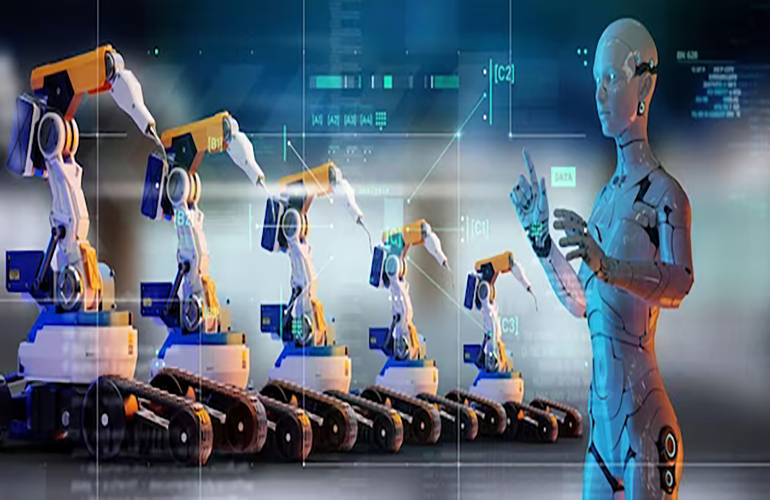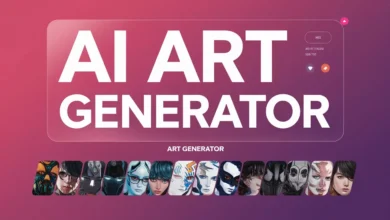
How Has Robotics Changed Manufacturing Technology with advanced automation and robotics technology
Advanced automation and robotics technology has revolutionized the manufacturing sector, sparking profound changes across industries. In this comprehensive exploration, we’ll delve into how robots have reshaped manufacturing and what lies ahead for the industry.
Advanced automation and robotics technology
The Rise of Robotics in Manufacturing
Which technological improvement did the industrial robot bring. The history of robotics in manufacturing dates back to the early 1960s when General Motors first introduced Unimate, a robotic arm designed to automate dangerous and repetitive tasks on the assembly line. This groundbreaking innovation marked the beginning of a new era in manufacturing – one that promised increased efficiency, productivity, and safety.
Over the years, advances in advanced automation and robotics technology have led to the development of more sophisticated and adaptable robots, capable of performing a wide range of tasks with speed and accuracy. Today, robots are an integral part of many manufacturing processes, from welding and painting to packaging and quality control.
The Impact on Manufacturing
The integration of robotics into manufacturing has had a significant impact on the industry. One major benefit is increased efficiency. Robots are capable of working non-stop, unlike humans who require breaks and shifts. This has resulted in faster production times and reduced downtime, leading to higher output levels.
Moreover, the precision and accuracy of robots have improved product quality, resulting in a lower defect rate and decreased waste. With their ability to handle hazardous materials and perform dangerous tasks without risk to human workers, robots have also greatly improved workplace safety.
Another key impact is the reduction of labor costs. While initial investment in robotics technology may be costly, it can ultimately lead to significant savings for manufacturing companies by reducing labor costs and increasing productivity.

The Future of Robotics in Manufacturing
As technology continues to advance at a rapid pace, so does the potential for robots to further transform the manufacturing industry. With the rise of artificial intelligence (AI) and machine learning, robots are becoming more intelligent and adaptable, capable of learning new tasks and improving processes on their own.
This has led to the emergence of “smart factories” where machines can communicate with each other and make real-time decisions based on data analysis. This level of automation promises even greater efficiency, productivity,
Evolution of Robotics in Manufacturing
The use of robots in manufacturing is not a modern phenomenon. In fact, the first industrial robot was introduced in 1961 by General Motors, designed to handle heavy lifting tasks on the assembly line. However, these early versions were large and clunky and had limited capabilities compared to today’s robots.
Over the years, advancements in technology
Understanding Robotics in the Manufacturing Context
First, it’s essential to understand the role of robotics in modern manufacturing. Robotics, in simple terms, refers to the science and engineering of creating robots, which are computer-controlled machines capable of performing tasks designed for human beings. In the manufacturing realm, industrial robots have revolutionized production by taking on repetitive or dangerous tasks that once were a staple of human employment.
The Technological Leap of Industrial Robots
The initial industrial robots were stationary, single-armed devices. Introduced in the 1960s, these robots could be programmed to undertake assembly line tasks that required precision and repetition. Early models, like the Unimate, transformed car manufacturing processes, increasing efficiency and safety. As we dig deeper, it’s evident that the technology behind these industrial robots evolved, offering greater flexibility and a wider range of tasks.
Enhanced Precision and Productivity
Industrial robots brought about an era of enhanced precision and productivity. The ability to repeatedly perform tasks with exact accuracy reduced variability in product quality and led to a sharp decline in production errors.
The Rise of the Collaborative Robot
More recently, we’ve witnessed the introduction of collaborative robots, or cobots. These machines work hand-in-hand with human employees and can be easily reprogrammed to perform different tasks – a monumental shift in the operational model of the manufacturing floor.
Robotics Technology Park: A Showcase of Innovation

Robotics Technology Parks are emerging as crucibles of innovation, where manufacturers can explore advanced robotic technologies in a controlled environment. These parks often boast state-of-the-art facilities to test and develop robotics for various manufacturing processes.
Real-World Applications and Demonstrations
One of the significant benefits of these parks is the ability for manufacturers to witness real-world applications and demonstrations of robotics technology. Such hands-on experiences can demystify these machines and underscore their practical benefits.
Research and Development Hub
Robotics Technology Parks also serve as research and development hubs, nurturing the next generation of robots. By providing a space for collaborative projects between industry and academia, these centers spark ideas that may not have materialized within traditional manufacturing environments.
In-Depth: Robot Insight Technologies
Robots are becoming increasingly sophisticated thanks to advancements in machine vision, tactile sensing, and other sensor technologies. These capabilities allow robots to ‘see’ and adjust to the environment around them, performing tasks with an awareness that was once the realm of science fiction.
Machine Vision and Sensing
Machine vision enables robots to identify and adapt to objects in their path, pick items from a conveyor belt with precision, and even carry out inspection tasks, autonomously.
Tactile Sensing
Robots equipped with tactile sensors can handle delicate materials without damage, sense when an operation requires greater force, or even work in congested spaces alongside human colleagues, without safety concerns.
The Technologic Robot: More Than Just Hardware

The modern robot is not just a machine — it’s a complex array of hardware, software, and data. Thanks to the Internet of Things (IoT) and cloud computing, robots are becoming smarter and more interconnected, capable of learning from each other and the data they produce.
Connectivity and Data Sharing
Robotics technology relies on connectivity to share data and enable collaborative manufacturing processes. Data sharing can lead to predictive maintenance, reduced downtime, and more efficient operations.
Learning and Adaptation
The latest robotic systems are built with AI and machine learning capabilities. They can adapt to changes on the manufacturing floor, optimize production schedules, and even predict maintenance requirements before a breakdown occurs.
Advanced Automation and Robotics: The Economic and Social Impact
The integration of advanced automation and robotics technology has far-reaching implications. On one hand, it promises to increase productivity, improve quality, and drive down costs. On the other, it raises questions about the future of employment and the upskilling required for the modern workforce.
Enhancing Manufacturing Competitiveness
Nations and companies that invest in advanced robotics hold a significant advantage in the global manufacturing arena. The speed and precision of robotic systems lead to a competitive edge that is difficult to match with manual labor alone.
Reskilling the Workforce
The deployment of robots in manufacturing necessitates a shift in the skills required of the workforce. This shift provides an opportunity for retraining and upskilling workers, preparing them for the new roles that will emerge in a more robotized manufacturing environment.
The Future: Robotics in Manufacturing Beyond Automation
The future relationship between robots and humans in manufacturing is fascinating to contemplate. As we look forward, there are significant trends and technologies that will reshape the industry even further.
Personalization and Customization
Robots will drive more personalized and customized manufacturing. The ability to quickly reprogram robots for new job tasks will allow for a high mix, low volume production that caters to specific customer demands.
Sustainable Robotics
Sustainability is a growing focus within manufacturing, and robotics can play a key role. By optimizing energy usage, reducing waste, and enabling green manufacturing processes, robots are set to lead the charge towards a more sustainable industry.
Conclusion
The robotics revolution in manufacturing technology has ushered us into an era of unprecedented potential and change. The line between human and machine capabilities is blurring, opening the door to new levels of efficiency and innovation. As the industry continues to evolve, companies and workers alike must adapt to these new paradigms. The key to success lies in embracing the potential of robotics while acknowledging and addressing the challenges they bring. It is an exciting time to be part of the manufacturing world, and the role of robotics in shaping its future cannot be understated.
Frequently Asked Questions (FAQs)
What are Robotics Technology Parks?
Robotics Technology Parks are specialized facilities that provide manufacturers with access to advanced robotic technologies, offering spaces for testing, development, and demonstrations of these technologies in a real-world setting.
How do robots learn and adapt in manufacturing?
Modern robotics systems often include AI and machine learning algorithms which allow them to learn from repeated actions and adapt to changes in their environment, ultimately optimizing production schedules and predicting maintenance needs.
Will robots replace human workers in manufacturing?
While robots are automating many tasks, they are not necessarily replacing human workers but instead changing the nature of manufacturing jobs. Efforts are increasing to retrain and reskill workers to prepare them for more advanced roles in a high-tech manufacturing environment.
Can robotics improve sustainability in manufacturing?
Indeed, robots can significantly improve sustainability by optimizing energy usage, reducing waste, and enabling more efficient manufacturing processes that reduce the industry’s carbon footprint.
How do tactile sensors enhance robot functionality?
Tactile sensors equip robots with the ability to handle sensitive materials carefully, apply necessary force during operations, and coexist in work areas safely alongside human workers.
Why is connectivity important in modern robotics?
Connectivity plays a critical role as it allows robots to share data, learn from one another, and work collaboratively in manufacturing processes, creating a more integrated and intelligent production environment.
What is the economic impact of advanced robotics in manufacturing?
Advanced robotics can increase productivity, drive down costs, and improve product quality. This contributes positively to the economic landscape by enhancing the competitiveness of the manufacturing sector.
Automation and robotics have revolutionized manufacturing, causing profound changes in all industries. This comprehensive exploration will explore how robots have transformed manufacturing and what the future holds for this industry.
Robotics in Manufacturing: The Rise of Robotics
General Motors introduced Unimate in the early 1960s, a robotic hand designed to automate repetitive and dangerous tasks on the assembly lines. This revolutionary innovation ushered in a new age of manufacturing, one that promised greater efficiency, productivity and safety.
Over the years, advancements in automation and robotics have led to more advanced and adaptable robots that are capable of performing many tasks with speed, accuracy, and precision. Robots are now an essential part of many manufacturing operations, including welding, painting, packaging, and quality control.
The Impact of Manufacturing
Integration of robotics in manufacturing has had an impact on the industry. The main benefit of robotics is improved efficiency. Robots can work continuously, unlike humans that need breaks and shifts. The result is faster production and less downtime. This leads to higher output.
Robots’ precision and accuracy have also improved the quality of products, leading to a reduction in defects and waste. Robots are also a great improvement in workplace safety because they can handle hazardous materials, perform dangerous tasks and do so without putting human workers at risk.
A reduction in labor costs is another key benefit. Although the initial investment may be expensive, it will ultimately result in significant savings for manufacturers by reducing labor cost and increasing productivity.
Robotics in Manufacturing: The Future of Robotics
Robots have the potential to transform manufacturing as technology advances at an accelerated pace. Robots are becoming smarter and more adaptable with the advent of artificial intelligence and machine learning. They can learn new tasks, and improve processes, on their own.
The emergence of smart factories, where machines communicate and can make decisions in real time based on data analytics has been a result. This level of automation promises greater productivity and efficiency.
Evolution of Robotics and Manufacturing
Robotics is not a new phenomenon. General Motors introduced the first industrial robotics in 1961, which was designed to perform heavy lifting on the assembly lines. These early versions, however, were large and cumbersome and had limited abilities compared to the robots of today.
Technology has evolved over the years.
Understanding Robotics within the Manufacturing Context
It’s important to first understand the role that robotics plays in modern manufacturing. In simple terms, robotics is the science and engineering behind creating robots that are computer-controlled machines able to perform tasks intended for humans. Industrial robots revolutionized manufacturing by tackling repetitive and dangerous tasks once performed by humans.
Industrial Robots: The Technological Leap
Initial industrial robots were single-armed, stationary devices. These robots were introduced in the 1960s and could be programmed for assembly line tasks requiring precision and repetition. Early models like the Unimate transformed car manufacturing, increasing safety and efficiency. It’s clear that as we dig deeper into the technology, these industrial robots have evolved to offer greater flexibility and more tasks.
Precision and Productivity Enhanced
The advent of industrial robots ushered in a new era marked by increased precision and productivity. The ability to perform repetitive tasks with perfect accuracy led to a reduction in variability in product quality.
Rise of the Collaborative Robot
Recently, collaborative robots or cobots have been introduced. These machines can easily be reprogrammed and work in tandem with humans. This is a major shift for the operation of manufacturing floors.
Robotics Technology Park – A showcase of innovation
Robotics Technology Parks have emerged as incubators of innovation where manufacturers can experiment with advanced robotic technologies under controlled conditions. These parks are often equipped with state-of the-art facilities for testing and developing robotics in various manufacturing processes.
Real-World Demonstrations and Applications
These parks offer manufacturers the opportunity to see robotics in action. These hands-on demonstrations can help to demystify robotic machines and highlight their practical value.
Research and Development Hub
Robotics Technology Parks are also hubs for research and development, fostering the next generation robots. These centers provide a collaborative space between industry and academia that can spark new ideas.
In-Depth Robot Insight Technologies
Machine vision, tactile sensors, and other sensor technology are advancing to make robots more sophisticated. These capabilities enable robots to adapt to their environment and’see’ it, a feat that was previously only possible in science fiction.
Machine Vision and Sensing
Robots can use machine vision to adapt and identify objects that are in their way, to pick up items with precision from a belt conveyor, or to carry out inspection tasks autonomously.
Tactile Sensing
The robots with tactile sensors are able to handle materials delicately without damaging them, detect when a greater force is needed, and even work in crowded spaces alongside humans without any safety concerns.
The Technologic Robot is More Than Hardware
Modern robots are more than just machines. They’re a complex combination of hardware, software and data. Robots are becoming more intelligent and interconnected thanks to cloud computing and the Internet of Things. They can also learn from one another and their data.
Connectivity and Data Share
Connectivity is essential for robotics technology to enable data sharing and collaborative manufacturing. Data sharing can result in predictive maintenance, decreased downtime and more efficient operations.
Learning and Adaptation
AI and machine-learning capabilities are built into the latest robotic systems. They can adapt to the changes in the factory floor, optimize production schedules and even predict maintenance needs before they occur.
Advanced Automation and Robotics – The Economic and Societal Impact
Integration of advanced automation technology and robotics has many implications. It promises to improve productivity, quality and reduce costs. It also raises concerns about the future of work and the skills required by the modern workforce.
Enhancing Manufacturing Competency
Investing in advanced robotics gives nations and companies a competitive edge in global manufacturing. Robotic systems are able to produce high-quality work at a speed and precision that manual labor cannot match.
Re-skilling the Workforce
Robotics is changing the way manufacturing workers are trained. This shift offers an opportunity to retrain and upskill workers in order to prepare them for new roles which will emerge as a result of a more roboticized manufacturing environment.
The Future of Robotics: Manufacturing Beyond Automation
It is interesting to think about the future of robots in manufacturing. Looking ahead, we can see that there are many trends and technologies which will further reshape this industry.
Personalization and Customization
Robots will enable more customized and personalized manufacturing. Rapidly reprogramming robots to perform new tasks will enable a low-volume, high-mix production to meet specific customer needs.
Sustainable Robotics
Robotics can be a major part of the manufacturing industry’s focus on sustainability. Robots will lead the way to a sustainable industry by optimizing energy use, reducing waste and enabling green manufacturing.
The conclusion of the article is:
Robotics has revolutionized manufacturing technology, bringing us to a new era of potential and change. The boundaries between machine and human capabilities are blurring. This opens the door to greater efficiency and innovation. Companies and workers must adapt as the industry evolves. Success lies in the ability to embrace the benefits of robotics, while also recognizing and addressing their challenges. The manufacturing industry is experiencing a period of great excitement, and robotics’ role in determining its future cannot be underestimated.
FAQs (Frequently Asked Questions)
What are Robotics Tech Parks?
Robotics Technology Parks (RTPs) are specialized facilities which provide manufacturers access to advanced robotic technology. They offer spaces for testing, demonstrations, and development of these technologies.
How can robots adapt and learn in manufacturing?
Modern robotics systems include AI and machine-learning algorithms that allow them to adapt to their changing environment and learn from repeated actions. This allows them to optimize production schedules, and predict maintenance needs.
Will robots replace humans in manufacturing?
Robots automate many tasks but they do not replace human workers. Instead, robots change the nature of manufacturing work. Workers are being retrained and reskilled to take on more advanced roles within a high-tech manufacturing setting.
Can robots help improve the sustainability of manufacturing?
Robots are a great way to improve sustainability. They can optimize energy use, reduce waste and enable more efficient manufacturing processes, which will lower the carbon footprint of an industry.
What are the benefits of tactile sensors for robots?
Robots equipped with tactile sensors are able to work safely in the same area as humans and handle sensitive materials.
Why is connectivity so important in modern robotics
Connectivity is a key factor in the manufacturing process, as it allows robots and other machines to work together, share data and learn from each other. This creates a more intelligent and integrated production environment.
What is the economic impact on advanced robotics?
Robotics advances can improve productivity, reduce costs and enhance product quality. The manufacturing sector becomes more competitive, which is good for the economy.



